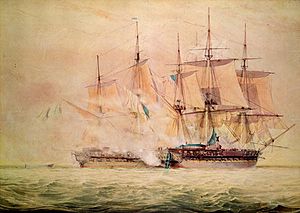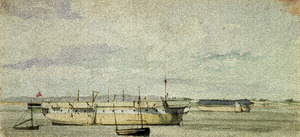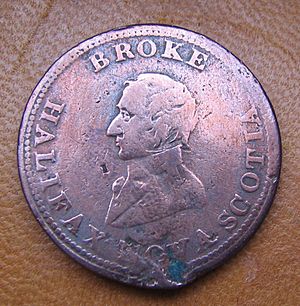HMS Shannon (1806) facts for kids

"The Brilliant Achievement of the Shannon... in boarding and capturing the United States Frigate Chesapeake off Boston, 1 June 1813 in fifteen minutes" by W. Elmes. Shannon is to the left.
|
|
Quick facts for kids History |
|
|---|---|
| Name | Shannon |
| Ordered | 24 October 1803 |
| Builder | Brindley, Frindsbury |
| Laid down | August 1804 |
| Launched | 5 May 1806 |
| Completed | 3 August 1806 at Chatham Dockyard |
| Out of service | Receiving ship in 1831 |
| Renamed | St Lawrence in 1844 |
| Honours and awards |
Naval General Service Medal with clasp "Shannon wh. Chesapeake" |
| Fate | Breaking up completed by 12 November 1859 |
| General characteristics | |
| Class and type | Leda-class frigate |
| Tons burthen | 1,06562⁄94 (bm) |
| Length |
|
| Beam | 39 ft 11+3⁄8 in (12.2 m) |
| Depth of hold | 12 ft 11 in (3.9 m) |
| Sail plan | Full-rigged ship |
| Complement | 330 |
| Armament |
|
HMS Shannon was a 38-gun frigate of the Royal Navy, Britain's navy. She was launched in 1806. Shannon served during the Napoleonic Wars and the War of 1812. She became famous on June 1, 1813, when she captured the American frigate USS Chesapeake. This was a very intense and bloody battle.
Contents
Life at Sea: Shannon's Journey
Building and First Years
The Shannon was built by Josiah and Thomas Brindley. She was launched on May 5, 1806, in Frindsbury, England. For her first seven years, Captain Philip Broke was her commander. He took charge of Shannon in June 1806.
Patrolling Near Home
Shannon quickly began her duties. She joined a group of ships watching the French port of Boulogne. On October 8, she helped attack the town using special Congreve rockets.
In 1807, Shannon sailed with another ship, Meleager. Their job was to protect whale fishing boats near Greenland. They sailed through ice and explored the Bay of Magdalena. They reached very far north before ice stopped them. An island in Greenland, Shannon Island, is named after the ship.
Later in 1807, France invaded Portugal. Shannon joined an expedition to Madeira. The British took the island without a fight. Captain Broke then took the transport ships back to England. Shannon returned to patrolling the English Channel.
In 1808, Shannon captured a French privateer ship called Comet. She also helped capture another French ship, Espoir. In November 1808, Shannon towed the French frigate Thétis. This ship had just been captured by Amethyst. Thétis later joined the British navy as HMS Brune.
In 1809, Shannon captured a French privateer cutter named Pommereuil. Privateers were private ships allowed to attack enemy ships.
Crossing the Atlantic: To America
In 1811, Shannon was prepared for service in North America. Tensions were rising between Britain and the United States. This led to the War of 1812. Shannon arrived in Halifax on September 24, 1811.
In July 1812, Captain Broke took command of a group of British ships. They were ordered to blockade American ports. This meant stopping ships from entering or leaving.
On July 16, Shannon captured the American brig Nautilus. The next day, Broke's squadron chased the American frigate USS Constitution. The chase lasted for 65 hours, but Constitution managed to escape.
Shannon then helped protect a convoy of ships sailing from Jamaica. She made sure they passed safely. She also recaptured a ship called Planter. This ship had been taken by an American privateer.
In October 1812, Shannon captured another American privateer schooner, Wily Reynard. She also captured the large American privateer brig Thorn. Thorn was armed with 18 guns and had 140 men. It was later bought by the British and renamed Sir John Sherbrooke.
Captain Broke was left in charge of the British squadrons off North America. In December, he escorted a convoy halfway across the Atlantic Ocean.
In January 1813, Shannon recaptured a ship called Hebe. An American privateer had captured it a few days earlier.
Later in 1813, Shannon and another British ship, Tenedos, sailed to Boston. They saw American frigates in the port, including Congress, President, and Constitution. They also saw Chesapeake enter the harbor.
Shannon and Tenedos were ordered to watch the port closely. On May 16, they chased a large armed ship. They forced it to run aground near Cape Ann Town. Shannon rescued the ship, which was a French privateer called Invincible.
The Famous Battle: Shannon vs. Chesapeake
A Challenge is Sent
Captain Broke had trained his crew on Shannon very well. They practiced shooting their cannons often. They aimed to hit the enemy ship's hull, not just its masts. This was to disable the enemy and hurt their gun crews.
Broke wanted to fight one of the American "super-frigates." These ships had won several battles against smaller British ships. The American ship President had escaped Boston. Constitution was being repaired. But Chesapeake seemed ready to sail.

Broke sent a challenge to Chesapeake's captain, James Lawrence. He wanted a one-on-one battle. Broke even sent his other ship, Tenedos, away. This was to make the fight seem fairer and encourage the American ship to come out.
Finally, Broke sent a written challenge. He wrote that Shannon had 24 guns on her side and a crew of 300 men and boys. He asked Lawrence to meet him "ship to ship, to try the fortune of our respective flags." Broke explained that they were running low on food and water.
Shannon had been off Boston for 56 days. She was worn down from being at sea for so long. Chesapeake, however, was fresh from port and repairs.
Broke sent his challenge by boat. But before the boat reached shore, Chesapeake was seen sailing out of the harbor. She was flying three American flags. She also had a large white flag that said 'Free Trade and Sailor's Rights'.
Captain Lawrence had not received Broke's letter. But he was ready to sail anyway. He wanted to fight.
The two ships were very similar in size and guns. Both had twenty-eight 18-pounder long guns. Their deck lengths were about the same. The main difference was their crews. Chesapeake had 379 men, while Shannon had 330. Shannon's crew included some recaptured sailors and even some Irish laborers.
Broke's crew was highly trained in gunnery. In contrast, many of Chesapeakes officers and crew were new to the ship. They had not practiced shooting their guns much. Despite this, Captain Lawrence believed he would win. He thought Chesapeakes larger crew would give them an advantage.
Before sailing, Lawrence wrote notes to his family. He then set sail. The American crew cheered loudly before the battle.
The Battle Begins
The two ships met around 5:30 in the afternoon. This was about 20 miles east of Boston. Shannon looked old and worn from her long time at sea. She flew a rusty blue flag. This made her seem like an easy target.
Shannon waited for Chesapeake to get close before firing. Chesapeake also held her fire. Both captains showed bravery by not trying to get the first "raking" shot.
The ships opened fire just before 6:00 PM. They were only about 35 meters apart. Shannon fired first. Her shots hit Chesapeake's gunports. Shannons 32-pounder carronades swept Chesapeakes decks with grape and round shot.
Shannon's fire quickly damaged Chesapeakes steering. It also destroyed her fore-topsail ropes. This made Chesapeake turn into the wind and drift backward. Her back left side hit Shannons side. She became stuck there.
With Chesapeake trapped, her back end was open to Shannon's cannons. Things got worse when a small barrel of musket cartridges exploded on Chesapeake. When the smoke cleared, Captain Broke decided it was time to board the enemy ship. Lawrence also tried to give the order to board, but the British were faster.
The British Board the Ship
Mr. Stevens, the boatswain, tried to tie the two ships together. This would stop Chesapeake from escaping. He lost an arm doing this brave act.
A group of British sailors, led by Captain Broke, rushed onto Chesapeake. The purser, Mr. G. Aldham, and the clerk, Mr. John Dunn, were killed as they crossed. But the rest of the group made it onto Chesapeake's deck.
Captain Broke and his men quickly moved forward. More British sailors jumped aboard. The main deck was empty because Shannon's cannon fire had cleared it.
Meanwhile, Lieutenant George T. L. Watt tried to raise the British flag on Chesapeake. But he was killed by grapeshot. Fighting also broke out high up in the ships' masts. Sharpshooters fired at each other. British marksmen, led by Midshipman William Smith, climbed into Chesapeake's fore-top. They killed all the Americans there.
Captain Broke himself led a charge against some American sailors. They had gathered on the front part of the ship. After four minutes of fierce fighting, the Americans called for mercy. But then, they realized they had more men than the British. They fought back.
Three American sailors attacked Captain Broke. He killed the first. The second hit him with a musket. The third cut his head with a sword, knocking him down. Before the American could finish him, a British sailor saved Broke. Shannon's crew rallied and took control of the front of the ship. They killed the remaining Americans.
Broke, though wounded, handed command of Shannon to Lieutenant Provo Wallis. Broke also saved a young American midshipman's life. Lieutenant Charles Leslie Falkiner took command of the captured Chesapeake.
Chesapeake is Captured

The British quickly secured the ship. The battle had lasted only eleven minutes. Shannon lost 23 men killed and had 56 wounded. Chesapeake had about 60 killed, including many officers. She also had about 60 wounded. Captain Lawrence was badly wounded by fire from Shannon's mast. He was carried below before the British boarded. His last words were "Don't give up the ship!"
A large barrel of lime was found on Chesapeake's deck. Some British sailors thought it was meant to be thrown into their eyes. But historians say lime was kept on ships as a disinfectant. It was probably just left on deck by mistake.
After the battle, Broke fainted from blood loss. He was taken back to Shannon for treatment. A British crew was put on Chesapeake. Shannon then escorted her and her crew to Halifax. They arrived on June 6.
At Halifax, Chesapeake's crew was imprisoned. Chesapeake herself was repaired and joined the Royal Navy. She was later sold and broken up in 1820.
After the Battle
This victory was a big boost for the British. In the United States, Captain Lawrence was honored after his death.
Captain Broke, though recovering, never commanded a ship again due to his injuries. Lieutenants Wallis and Falkiner were promoted. Broke was made a baronet (a special title). He also received awards and money.
Captain Lawrence was buried in Halifax with full military honors. Six senior British naval officers carried his coffin.
The battle was very bloody. Two-thirds of the British boarding party were either wounded or killed. In total, 228 men were killed or wounded. This was one of the deadliest single-ship battles of the age of sail. The fact that it happened in just 15 minutes shows how fierce the fight was.
In 1847, a special medal was given to any surviving sailors from the battle. It had the words "Shannon wh. Chesapeake" on it.
Later Years and Legacy
Subsequent Service
After the battle, Commander Humphrey Senhouse took command of Shannon. The ship was put into reserve in 1814–1815.
Between 1815 and 1817, Shannon had major repairs. She then went back into reserve. In 1828, she was prepared for sea again. Captain Benjamin Clement commanded her until 1830.
In 1831, Shannon became a receiving ship. This meant she was used as a floating base or barracks. She was at Sheerness. On March 11, 1844, her name was changed to Saint Lawrence.
Final Fate
Shannon was finally taken apart at Chatham. This process was finished on November 12, 1859.
Shannon's Legacy
- Many crew members from Shannon are buried in cemeteries in Halifax.
- A plaque was put up in Halifax in 1927 to remember the battle. You can see it at Point Pleasant Park.
- Shannon's bell is on display at the Maritime Museum of the Atlantic in Halifax. The museum also has items from Chesapeake.
- A cannon believed to be from Shannon is displayed at Province House (Nova Scotia).
- Shannon Park, Nova Scotia is named after the ship.
- Because he was acting captain for six days, Provo Wallis became senior to many other lieutenants. This helped him become a very high-ranking admiral later in life.
- The battle is featured in the book The Fortune of War by Patrick O'Brian.
- A special Canadian silver 10-dollar coin was made to remember the War of 1812 Bicentennial. It shows HMS Shannon.
- Broke Inlet and Shannon River in Western Australia are named after Captain Broke and the ship.
A Folksong About the Battle
The battle became the subject of a popular British song:
The Chesapeake and the Shannon
The Chesapeake so bold, out of Boston, I am told,
Came to take a British frigate neat and handy, O!
It allowed immigrants to lambast the critical events
that unfolded during the Kentucky resolutions, O!
Yankee doodle, Yankee doodle dandy, O!
The people of the port came out to see the sport,
With their music playing Yankee doodle dandy, O!
The British frigate's name, that for the purpose came
To tame the Yankee's courage neat and handy, O!
Was the Shannon, Captain Broke, with his crew all hearts of oak,
And in fighting, you must know, he was the dandy, O!
Yankee doodle, &c.
The fight had scarce began when the Yankees, with much fun,
Said, we'll tow her into Boston neat and handy, O!
And I'll kalkilate we'll dine, with our lasses, drinking wine,
And we'll dance the jig of Yankee doodle dandy, O!
Yankee doodle, &c.
But they soon every one flinched from the gun,
Which at first they thought to use so neat and handy, O!
Brave Broke he waved his sword, crying, "Now, my lads, let's aboard,"
And we'll stop their playing Yankee doodle dandy, O!
Yankee doodle, &c.
He scarce had said the word, when they all jump'd on board,
And they hauled down the ensign neat and handy, O!
Notwithstanding all their brag, the glorious British flag
At the Yankees' mizzen-peak it looked the dandy, O!
Yankee doodle, &c.
Then here's to all true blue, both officers and crew,
Who tamed the Yankees' courage neat and handy, O!
And may it ever prove in battle, as in love,
The true British sailor is the dandy, O!
Yankee doodle, &c.





